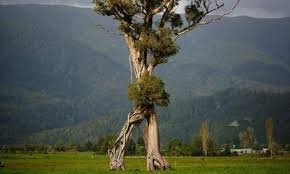Note: If you wish to receive, via e-mail, (1) my weekly newsletter or (2) daily copies of these posts, write to me at rrbates1951@gmail.com. Comments may also be sent to this address. I promise not to share your e-mail with anyone. To unsubscribe, write here as well.
Tuesday
Here’s a fascinating article that I somehow stumbled upon, maybe through Spoutible (which I now use instead of Twitter). The headline says it all:
100-foot ‘walking tree’ in New Zealand looks like an Ent from Lord of the Rings — and is the lone survivor of a lost forest
The article goes on to elaborate:
An unusual northern rātā tree that looks like it is striding across an empty field has been crowned New Zealand’s Tree of the Year. The giant plant, which looks strikingly similar to an Ent from The Lord of the Rings, is centuries old.
The strange tree, which has been nicknamed the “walking tree” because it looks like it’s striding across a field, is a northern rātā (Metrosideros robusta) — one of New Zealand’s tallest flowering tree species that can live for up to 1,000 years.
After reading the story and looking at the photo, I had to go back and check out exactly how Tolkien’s Ents walk. Here’s what I found:
Holding the hobbits gently but firmly, one in the crook of each arm, Treebeard lifted up first one large foot and then the other, and moved them to the edge of the shelf. The rootlike toes grasped the rocks. Then carefully and solemnly, he stalked down from step to step, and reached the floor of the Forest. At once he set off with long deliberate strides through the trees, deeper and deeper into the wood, never far from the stream, climbing steadily up towards the slopes of the mountains. Many of the trees seemed asleep, or as unaware of him as of any other creature that merely passed by; but some quivered, and some raised up their branches above his head as he approached.
And then there’s this detail that caught my attention:
All the while, as he walked, he talked to himself in a long running stream of musical sounds.
This put me in mind of a book written by a biology professor here at Sewanee, David Haskell’s The Songs of the Trees: Stories from Nature’s Great Connectors. Looking at the different sounds connected with a variety of trees, Haskell describes such communication systems as the following, which involves a balsam fir:
This network of communication also includes leaves. There plant cells not only sniff the air to detect the health of neighbors but also use airborne odors to attract helpful caterpillar-eating insects. Sound plays a role in this communication. When a leaf senses the vibrations of a caterpillar’s moving jaws, those chewing sounds cause the leaf to mount a chemical defense against the insect. Leaf cells therefore integrate chemical and acoustic cues as they sense and respond to their surroundings.
The article mentioning that the rātā is “the lone survivor of a lost forest” leaves us to wonder whether it is searching for the lost Entwives. Treebeard recalls his last encounter with his own love:
Very fair she was still in my eyes, when I had last seen her, though little like the Entmaiden of old. For the Entwives were bent and browned by their labor; their hair parched by the sun to the hue of ripe corn and their cheeks like red apples. Yet their eyes were still the eyes of our own people.
Once, he says, the land of the Entwives
blossomed richly, and their fields were full of corn. Many men learned the crafts of the Entwives and honored them greatly; but we were only a legend to them, a secret in the heart of the forest. Yet here we still are, while all the gardens of the Entwives are wasted: Men call them the Brown Lands now.
That’s what the Ents discovered when they went in search. The passage may owe something to the fields of Flanders, scorched by World War I, which Tolkien witnessed first hand:
We crossed over Anduin and came to their land; but we found a desert: it was all burned and uprooted, for war had passed over it. But the Entwives were not there. Long we called, and long we searched; and we asked all folk that we met which way the Entwives had gone. Some said they had never seen them; and some said that they had seen them walking away west, and some said east, and others south. But nowhere that we went could we find them. Our sorrow was very great. Yet the wild wood called, and we returned to it. For many years we used to go out every now and again and look for the Entwives, walking far and wide and calling them by their beautiful names. But as time passed we went more seldom and wandered less far. And now the Entwives are only a memory for us, and our beards are long and grey.
So we now know what the Ents look like when they go out searching. The longing for a bygone era brings to mind a line by the World War I poet Wilfred Owen: “Now men will go content with what we spoiled.” But the wilderness that has been lost is, at least, recalled by elves in a song they have written about the Ents and Entwives. Here’s an excerpt:
Ent: When Winter comes, the winter wild that hill and wood shall slay;
When trees shall fall and starless night devour the sunless day;
When wind is in the deadly East, then in the bitter rain
I’ll look for thee, and call to thee; I’ll come to thee again!
Entwife: When Winter comes, and singing ends; when darkness falls at last;
When broken is the barren bough, and light and labor past;
I’ll look for thee, and wait for thee, until we meet again:
Together we will take the road beneath the bitter rain!
Both: Together we will take the road that leads into the West,
And far away will find a land where both our hearts may rest.’
See this both as a lament for the environment we have destroyed but perhaps, also, as a spur to reforestation efforts.


